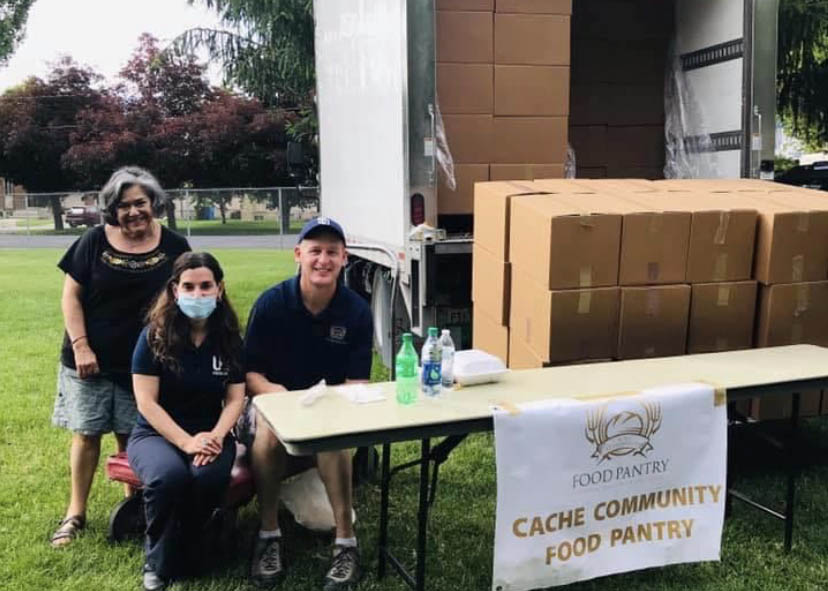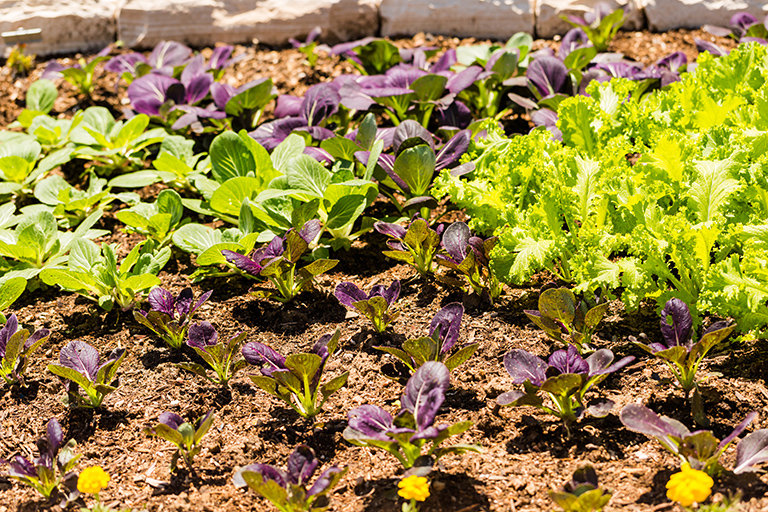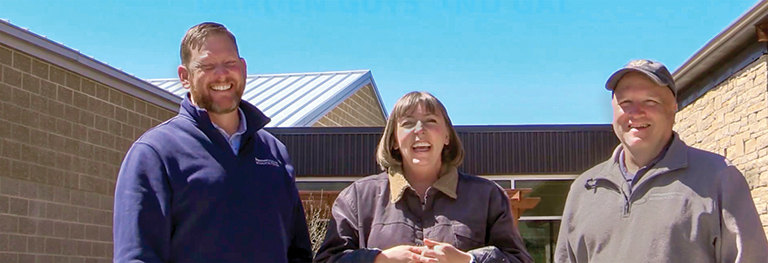Impacts: COVID-19
The Problem
In the Survey of Mothers with Young Children, 17.4 percent with children 12 years old and under reported that since the pandemic started, “The children in my household were not eating enough because we just couldn’t afford enough food.” Of those mothers, 3.4 percent reported that it was often the case that their children were not eating enough due to a lack of resources since the coronavirus pandemic began.
couldn’t afford enough food
are often not eating enough

Helping Agricultural Producers
The Coronavirus Farm Assistance Program (CFAP), administered through the USDA Farm Service Agency, began the end of May and runs through August. This is the first program directed at farmers based on impacts from COVID-19. USU held a webinar in cooperation with the Utah Farm Service Agency on June 4. A recording of the webinar is available at extension.usu.edu/apec/farm-financial-health. The webinar provides details of the program and how to fill out the application. This program focuses on dairy and livestock.

Community Partnerships
Farmers Feeding Utah Performs Three Miracle Projects
In 2018, Utah State University was approved by the Board of Regents to house a Hunger Solutions Institute. The institute works with professors, agencies, and communities to solve hunger issues throughout Utah, the nation, and the world by helping those with limited resources obtain access to healthy food choices. Utah’s Create Better Health SNAP-Ed mission mirrors USDA’s Food and Nutrition Services mission to work with partners to provide food and nutrition education to people in need in a way that inspires public confidence and supports American agriculture.
When the food system is interrupted, as it is now with COVID-19, our food options become limited. During these unusual circumstances, it is crucial to support those who work so hard to provide us with the products we consume and require for survival. The idea of farmers having nowhere to send or process their commodities, while so many people are not sure if they will have enough to eat, is tragic. Farmers Feeding Utah is designed to avert this tragedy by supporting the livelihood of our local farmers and also making sure those in need have access to healthy food.
To date, Farmers Feeding Utah, a partnership between the Utah Farm Bureau, Utah State University, and various community stakeholders, has completed three miracle projects: 1) the Navajo Nations, 2) Northern Utah and 3) West Salt Lake. These projects are miracles for farmers, whose products are purchased, and for families in need, who receive donated food.
Navajo Nation Miracle Project
Farmers Feeding Utah donated
605
live sheep
16,000 lbs
of frozen lamb
10,000 lbs
of flour
4,000+
individuals fed
to members of the Utah Chapters of the Navajo Reservation
The retail value of the food received was ~$200,000
Northern Utah Miracle Project
Farmers Feeding Utah donated
42,000 lbs
of potatoes
20,000 lbs
of beef
19,000
dozen eggs
$100,000
of dairy
to 450 families in Cache Valley and to stock four local food pantries
The retail value of the food received was ~$331,000
West Salt Lake Miracle Project
Farmers Feeding Utah donated
16,000 lbs
of meat
850 dozen
ears of corn
240,000 lbs
of potatoes
800 lbs
of cherries
350 lbs
of garlic
to 450 families in Cache Valley and to stock four local food pantries
The retail value of the food received was ~$331,000
COVID-19 Community Efforts by USU Extension in Cache County




Without This, I Wouldn’t Get to Eat Vegetables
USU Extension Senior Pop-Up Farmers Markets

It is anticipated that food insecurity has been exacerbated by the COVID-19 pandemic. The USU Extension Senior Pop-Up Farmers Market is a partnership with Salt lake County Aging and Adult Services and various other organizations that provide produce to seniors. USU has 21 scheduled farmers markets in 2020, due to anticipated higher numbers of seniors attending markets as well as a higher demand for produce.
According to the 2010 census
In 2019, the USU Extension Senior Pop-Up Farmers Market partnership provided
"Having this is good for the community. Lots of people don't eat healthy. If they could get fresh produce, they would eat it.”
"Having this is good for the community. Lots of people don't eat healthy. If they could get fresh produce, they would eat it.”
Utah State University Botanical Center
The mission of the USU Botanical Center Gardens is twofold: to teach specific horticulture skills to the public demonstrating varieties that can be grown in Utah, and to distribute locally grown, quality produce to food insecure populations in Davis County. A partnership with the Bountiful Food Pantry started in 2018 to identify at-risk groups in Davis County that could benefit from fresh produce being delivered every other week. The program delivers to a subsidized housing area and to an elderly care facility. Any excess produce is donated to the Bountiful Food Pantry where it is distributed to clients who are food insecure.
Urban Farm Demo Garden
1/8 Acre planted intensively, includes vegetables, cut flowers, small fruits, and tree fruits
| Produce donations | |
|---|---|
| 2019 | 1,502 lbs = $2,397 value |
| 2020 | 2,000 lbs of produce projected |
Edible Demo Garden
- 1/2 Acre tree fruits
- 1/4 Acre small fruits
- 1/4 Acre vegetables
| Produce donations | |
|---|---|
| 2019 | 3,453 lbs = $7,710 value |
| 2020 | 4,000 lbs of produce projected |


Increased Demand for Gardening Information
USU Extension offices statewide have seen a massive increase in the demand for basic gardening information, especially related to growing edibles. In response, USU faculty members in Davis and Cache counties have teamed up to create “The Garden Guys and Gal” social media group as a means to address many common questions that are being asked statewide. The page launched April 17 on social media and quickly gained over 500 followers on Facebook and 116 on Instagram. The faculty have made 87 posts on both platforms and have received a great response from the public.
| USU Extension YouTube Views | ||
|---|---|---|
| 2019 March-June | 460,721 | +83% |
| 2020 March-June | 844,799 | |
| USU Extension YouTube Hours of Watch Time | ||
|---|---|---|
| 2019 March-June | 25,709 | +77% |
| 2020 March-June | 45,633 | |
| Garden.usu.edu Page Views | ||
|---|---|---|
| 2019 March-June | 126,167 | +283% |
| 2020 March-June | 483,498 | |
| Garden.usu.edu Website Users | ||
|---|---|---|
| 2019 March-June | 43,509 | +83% |
| 2020 March-June | 79,630 | |
| USU Extension's Gardening Experts Facebook Group | ||
|---|---|---|
| January 2020 | 1,196 | +508% |
| June 2020 | 7,275 | |



A Sense of Security from Preserving Foods at Home

There are many reasons home food preservation is popular. Some preserve food to save money, for food security, or to have more control over ingredients and production practices. Food preservation popularity has been accelerated by the current COVID-19 pandemic, and online resources and Facebook Live events have seen a marked increase in use. Whatever the reason for preserving food, it is important to remember to follow research-based, tested, and food-safe recipes and processes.
-
Canning
-
Drying
-
Freezing
-
Storage
-
Pickling
-
Packaging
-
Nutrition


 Utah 4-H & Youth
Utah 4-H & Youth